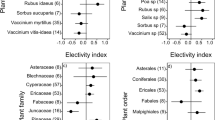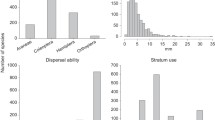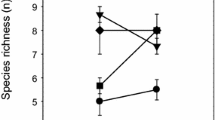Abstract
Food preferences and food availability are two major determinants of the diet of generalist herbivores and of their spatial distribution. How do these factors interact and eventually lead to diet differentiation in co-occurring herbivores? We quantified the diet of four grasshopper species co-occurring in subalpine grasslands using DNA barcoding of the plants contained in the faeces of individuals sampled in the field. The food preferences of each grasshopper species were assessed by a choice (cafeteria) experiment from among 24 plant species common in five grassland plots, in which the four grasshoppers were collected, while the habitat was described by the relative abundance of plant species in the grassland plots. Plant species were characterised by their leaf economics spectrum (LES), quantifying their nutrient vs. structural tissue content. The grasshoppers’ diet, described by the mean LES of the plants eaten, could be explained by their plant preferences but not by the available plants in their habitat. The diet differed significantly across four grasshopper species pairs out of six, which validates food preferences assessed in standardised conditions as indicators for diet partitioning in nature. In contrast, variation of the functional diversity (FD) for LES in the diet was mostly correlated to the FD of the available plants in the habitat, suggesting that diet mixing depends on the environment and is not an intrinsic property of the grasshopper species. This study sheds light on the mechanisms determining the feeding niche of herbivores, showing that food preferences influence niche position whereas habitat diversity affects niche breadth.



Similar content being viewed by others
References
Asshoff R, Hattenschwiler S (2005) Growth and reproduction of the alpine grasshopper Miramella alpina feeding on CO2-enriched dwarf shrubs at treeline. Oecologia 142:191–201
Baamrane MAA, Shehzad W, Ouhammou A, Abbad A, Naimi M, Coissac E, Taberlet P, Znari M (2012) Assessment of the food habits of the Moroccan dorcas gazelle in M’Sabih Talaa, West central Morocco, using the trnL approach. PLoS One 7:e35643
Behmer ST (2009) Insect herbivore nutrient regulation. Annu Rev Entomol 54:165–187
Behmer ST, Joern A (2008) Coexisting generalist herbivores occupy unique nutritional feeding niches. Proc Natl Acad Sci 105:1977–1982
Behmer ST, Simpson SJ, Raubenheimer D (2002) Herbivore foraging in chemically heterogeneous environments: nutrients and secondary metabolites. Ecology 83:2489–2501
Bellemain E, Carlsen T, Brochmann C, Coissac E, Taberlet P, Kauserud H (2010) ITS as an environmental DNA barcode for fungi: an in silico approach reveals potential PCR biases. BMC Microbiol 10:189
Belovsky GE (1986) Generalist herbivore foraging and its role in competitive interactions. Am Zool 26:51–69
Bernays EA, Bright KL (2005) Distinctive flavours improve foraging efficiency in the polyphagous grasshopper, Taeniopoda eques. Anim Behav 69:463–469
Bernays EA, Chapman RF (1970) Food selection by Chorthippus parallelus (Zetterstedt) (Orthoptera: Acrididae) in the field. J Anim Ecol 39:383–394
Bernays EA, Chapman RF (1994) Host plant selection by phytophagous insects. Springer, New York
Bernays EA, Bright KL, Gonzalez N, Angel J (1994) Dietary mixing in a generalist herbivore: tests of two hypotheses. Ecology 75:1997–2006
Cornelissen JHC, Lavorel S, Garnier E, Díaz S, Buchmann N, Gurvich DE, Reich PB, ter Steege H, Morgan HD, van der Heijden MGA, Pausas JG, Poorter H (2003) A handbook of protocols for standardised and easy measurement of plant functional traits worldwide. Aust J Bot 51:335–380
Franzke A, Unsicker SB, Specht J, Koehler G, Weisser WW (2010) Being a generalist herbivore in a diverse world: how do diets from different grasslands influence food plant selection and fitness of the grasshopper Chorthippus parallelus? Ecol Entomol 35:126–138
Fry B, Joern A, Parker PL (1978) Grasshopper food web analysis: use of carbon isotope rates to examine feeding relationships among terrestrial herbivores. Ecology 59:498–506
Garnier E, Shipley B, Roumet C, Laurent G (2001) A standardized protocol for the determination of specific leaf area and leaf dry matter content. Funct Ecol 15:688–695
Garnier E, Cortez J, Billès G, Navas M-L, Roumet C, Debussche M, Laurent G, Blanchard A, Aubry D, Bellmann A, Neill C, Toussaint J-P (2004) Plant functional markers capture ecosystem properties during secondary succession. Ecology 85:2630–2637
Gross N, Suding KN, Lavorel S (2007) Leaf dry matter content and lateral spread predict response to land-use change for six subalpine grassland species. J Veg Sci 18:289–300
Joern A (1979) Feeding patterns in grasshoppers (Orthoptera: Acrididae): factors influencing diet specialization. Oecologia 38:325–347
Joern A (1982) Vegetation structure and microhabitat selection in grasshoppers (Orthoptera: Acrididae). Southwest Nat 27:197–209
Jurado-Rivera JA, Vogler AP, Reid CAM, Petitpierre E, Gómez-Zurita J (2009) DNA barcoding insect–host plant associations. Proc R Soc B Biol Sci 276:639–648
Laliberté E, Legendre P (2010) A distance-based framework for measuring functional diversity from multiple traits. Ecology 91:299–305
Lavorel S, Grigulis K, McIntyre S, Williams NSG, Garden D, Dorrough J, Berman S, Quetier F, Thebault A, Bonis A (2008) Assessing functional diversity in the field—methodology matters! Funct Ecol 22:134–147
Lavorel S, Grigulis K, Lamarque P, Colace M-P, Garden D, Girel J, Pellet G, Douzet R (2011) Using plant functional traits to understand the landscape distribution of multiple ecosystem services. J Ecol 99:135–147
Leslie DM Jr, Vavra M, Starkey EE, Slater RC (1983) Correcting for differential digestibility in microhistological analyses involving common coastal forages of the Pacific Northwest. J Range Manage 36:730–732
Moretti M, De Bello F, Ibanez S, Fontana S, Pezzatti B, Dziock F, Rixen C, Lavorel S (2013) Linking traits between plants and invertebrate herbivores to track functional effects of environmental changes. J Veg Sci (in press)
Needleman SB, Wunsch CD et al (1970) A general method applicable to the search for similarities in the amino acid sequence of two proteins. J Mol Biol 48:443–453
Ogden J (1976) Some aspects of herbivore–plant relationships on Caribbean reefs and seagrass beds. Aquat Bot 2:103–116
Orav-Kotta H, Kotta J (2004) Food and habitat choice of the isopod Idotea baltica in the northeastern Baltic Sea. Hydrobiologia 514:1–3
Orrock JL, Danielson BJ, Brinkerhoff RJ (2004) Rodent foraging is affected by indirect, but not by direct, cues of predation risk. Behav Ecol 15:433–437
Peeters PJ, Sanson GD, Read J (2007) Leaf biomechanical properties and the densities of herbivorous insect guilds. Funct Ecol 21:246–255
Pegard A, Miquel C, Valentini A, Coissac E, Bouvier F, François D, Taberlet P, Engel E, Pompanon F (2009) Universal DNA-based methods for assessing the diet of grazing livestock and wildlife from feces. J Agric Food Chem 57:5700–5706
Pérez-Harguindeguy N, Díaz S, Vendramini F, Cornelissen JHC, Gurvich DE, Cabido M (2003) Leaf traits and herbivore selection in the field and in cafeteria experiments. Aust Ecol 28:642–650
Pompanon F, Deagle BE, Symondson WOC, Brown D, Jarman SN, Taberlet P (2012) Who is eating what: diet assessment using next generation sequencing. Mol Ecol 21:1931–1950
Pontes L, Soussana JF, Louault F, Andueza D, Carrere P (2007) Leaf traits affect the above-ground productivity and quality of pasture grasses. Funct Ecol 21:844–853
Quétier F, Thébault A, Lavorel S (2007) Plant traits in a state and transition framework as markers of ecosystem response to land-use change. Ecol Monogr 77:33–52
R Development Core Team (2011) R: a language and environment for statistical computing. R Foundation for Statistical Computing, Vienna
Raubenheimer D, Simpson SJ (2003) Nutrient balancing in grasshoppers: behavioural and physiological correlates of dietary breadth. J Exp Biol 206:1669–1681
Rowell-Rahier M (1984) The presence or absence of phenolglycosides in Salix (Salicaceae) leaves and the level of dietary specialisation of some of their herbivorous insects. Oecologia 62:26–30
Schädler M, Jung G, Auge H, Brandl R (2003) Palatability, decomposition and insect herbivory: patterns in a successional old-field plant community. Oikos 103:121–132
Simpson SJ, Raubenheimer D (1993) A multi-level analysis of feeding behaviour: the geometry of nutritional decisions. Philos Trans R Soc Lond B 342:381–402. doi:10.1098/rstb.1993.0166
Simpson SJ, Sibly RM, Lee KP, Behmer ST, Raubenheimer D (2004) Optimal foraging when regulating intake of multiple nutrients. Anim Behav 68:1299–1311
Singer M, Stireman J (2001) How foraging tactics determine host-plant use by a polyphagous caterpillar. Oecologia 129:98–105
Soininen EM, Valentini A, Coissac E, Miquel C, Gielly L, Brochmann C, Brysting AK, Sønstebø JH, Ims RA, Yoccoz NG et al (2009) Analysing diet of small herbivores: the efficiency of DNA barcoding coupled with high-throughput pyrosequencing for deciphering the composition of complex plant mixtures. Front Zool 6:16
Specht J, Scherber C, Unsicker SB, Kohler G, Weisser WW (2008) Diversity and beyond: plant functional identity determines herbivore performance. J Anim Ecol 77:1047–1055
Speiser B, Rowell-Rahier M (1991) Effects of food availability, nutritional value, and alkaloids on food choice in the generalist herbivore Arianta arbustorum (Gastropoda: Helicidae). Oikos 62:306–318
Staudacher K, Wallinger C, Schallhart N, Traugott M (2011) Detecting ingested plant DNA in soil-living insect larvae. Soil Biol Biochem 43:346–350
Sword GA, Joern A, Senior LB (2005) Host plant-associated genetic differentiation in the snakeweed grasshopper, Hesperotettix viridis (Orthoptera: Acrididae). Mol Ecol 14:2197–2205
Taberlet P, Coissac E, Pompanon F, Gielly L, Miquel C, Valentini A, Vermat T, Corthier G, Brochmann C, Willerslev E (2007) Power and limitations of the chloroplast trnL (UAA) intron for plant DNA barcoding. Nucl Acids Res 35:e14
Thébault E, Fontaine C (2008) Does asymmetric specialization differ between mutualistic and trophic networks? Oikos 117:555–563
Unsicker SB, Oswald A, Kohler G, Weisser WW (2008) Complementarity effects through dietary mixing enhance the performance of a generalist insect herbivore. Oecologia 156:313–324
Unsicker SB, Franzke A, Specht J, Köhler G, Linz J, Renker C, Stein C, Weisser WW (2010) Plant species richness in montane grasslands affects the fitness of a generalist grasshopper species. Ecology 91:1083–1091
Valentini A, Miquel C, Nawaz MA, Bellemain E, Coissac E, Pompanon FCO, Gielly L, Cruaud C, Nascetti G, Wincker P et al (2009) New perspectives in diet analysis based on DNA barcoding and parallel pyrosequencing: the trnL approach. Mol Ecol Resour 9:51–60
Wright IJ, Reich PB, Westoby M, Ackerly DD, Baruch Z, Bongers F, Cavender-Bares J, Chapin T, Cornelissen JHC, Diemer M, Flexas J, Garnier E, Groom PK, Gulias J, Hikosaka K, Lamont BB, Lee T, Lee W, Lusk C, Midgley JJ, Navas M-L, Niinemets Ü, Oleksyn J, Osada N, Poorter H, Poot P, Prior L, Pyankov VI, Roumet C, Thomas SC, Tjoelker MG, Veneklaas EJ, Villar R (2004) The worldwide leaf economics spectrum. Nature 428:821–827
Acknowledgments
We are grateful to Simone Fontana, Stéphane Bec and Louise Boulangeat for their help during field work, to Rolland Douzet for his help with plant identification, and to Kurtis Gautschi for his help with the English language. Comments from two anonymous reviewers allowed significant improvements of the manuscript. This research was conducted on the long-term research site Zone Atelier Alpes (ZAA), part of the International Long-Term Ecological Research-Europe network. This work is ZAA publication no. 26.
Data accessibility
The Fasta file and filtered data of the DNA-based diet analysis are deposited in the Dryad repository: http://doi.org/10.5061/dryad.fr0pd.
Author information
Authors and Affiliations
Corresponding author
Additional information
Communicated by Roland Brandl.
Electronic supplementary material
Below is the link to the electronic supplementary material.
Rights and permissions
About this article
Cite this article
Ibanez, S., Manneville, O., Miquel, C. et al. Plant functional traits reveal the relative contribution of habitat and food preferences to the diet of grasshoppers. Oecologia 173, 1459–1470 (2013). https://doi.org/10.1007/s00442-013-2738-0
Received:
Accepted:
Published:
Issue Date:
DOI: https://doi.org/10.1007/s00442-013-2738-0




